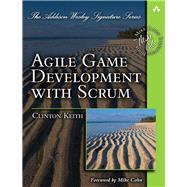
What is included with this book?
Preface xix
Acknowledgments xxiii
About the Author xxv
Part I: The Problem and the Solution 1
Chapter 1: The Crisis Facing Game Development 3
A Brief History of Game Development 4
The Crisis 10
A Silver Lining 11
Additional Reading 12
Chapter 2: Agile Development 13
Why Projects Are Hard 14
Why Use Agile for Game Development? 20
What an Agile Project Looks Like 28
The Challenge of Agile 32
Additional Reading 32
Part II: Scrum and Agile Planning 33
Chapter 3: Scrum 35
The History of Scrum 36
Scrum Parts 41
Scrum Roles 44
Customers and Stakeholders 54
Chickens and Pigs 55
Scaling Scrum 56
Summary 56
Additional Reading 57
Chapter 4: Sprints 59
The Big Picture 59
Planning 59
Tracking Progress 68
The Daily Scrum Meeting 74
Sprint Reviews 75
Retrospectives 78
Summary 84
Additional Reading 84
Chapter 5: User Stories 85
A Fateful Meeting 85
What Are User Stories? 87
Levels of Detail 88
Conditions of Satisfaction 90
Using Index Cards for User Stories 92
INVEST in User Stories 92
User Roles 97
Defining Done 99
Collecting Stories 100
Advantages of User Stories 103
Summary 105
Additional Reading 105
Chapter 6: Agile Planning 107
Why Agile Planning? 107
The Product Backlog 108
Estimating Story Size 112
Release Planning 117
Summary 124
Additional Reading 124
Part III: Agile Game Development 125
Chapter 7: Video Game Project Planning 127
Midnight Club Story 127
Minimum Required Feature Sets 128
The Need for Stages 130
The Development Stages 130
Mixing the Stages 132
Managing Stages with Releases 132
Production on an Agile Project 134
Summary 155
Additional Reading 155
Chapter 8: Teams 157
Great Teams 158
A Scrum Approach to Teams 159
Game Teams and Collaboration 168
Scaling and Distributing Scrum 173
Summary 188
Additional Reading 188
Chapter 9: Faster Iterations 189
Where Does Iteration Overhead Come From? 190
Measuring and Displaying Iteration Time 191
Personal and Build Iteration 193
Summary 201
Additional Reading 201
Part IV: Agile Disciplines 203
Chapter 10: Agile Technology 205
The Problems 205
An Agile Approach 210
Summary 220
Additional Reading 221
Chapter 11: Agile Art and Audio 223
The Problems We Are Solving with Agile 223
Concerns About Agile 225
Art Leadership 226
Art on a Cross-Discipline Team 227
Summary 232
Additional Reading 233
Chapter 12: Agile Design 235
The Problems 236
Designing with Scrum 237
Summary 247
Additional Reading 247
Chapter 13: Agile QA and Production 249
Agile QA 249
The Role of QA on an Agile Game Team 252
Agile Production 259
Summary 262
Additional Reading 263
Part V: Getting Started . 265
Chapter 14: The Myths and Challenges of Scrum 267
Silver Bullet Myths . 267
Fear, Uncertainty, and Doubt 269
Scrum Challenges 273
Summary 281
Additional Reading 282
Chapter 15: Working with a Publisher 283
The Challenges 284
Building Trust, Allaying Fear 288
Agile Contracts 293
Summary 300
Additional Reading 300
Chapter 16: Launching Scrum 301
The Three Stages of Adoption 301
Adoption Strategies 317
Summary 324
Additional Reading 324
Conclusion 325
Bibliography 327
Index 329
The New copy of this book will include any supplemental materials advertised. Please check the title of the book to determine if it should include any access cards, study guides, lab manuals, CDs, etc.
The Used, Rental and eBook copies of this book are not guaranteed to include any supplemental materials. Typically, only the book itself is included. This is true even if the title states it includes any access cards, study guides, lab manuals, CDs, etc.